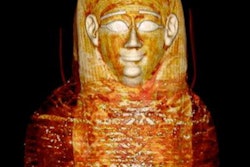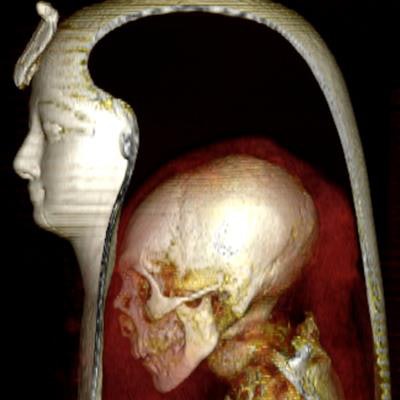
Imaging has revealed detailed information about Amenhotep I, a 3,500-year-old wrapped mummy. The Egyptian study involved a noninvasive virtual "unwrapping" of the mummy layer by layer, and has provided new data about the pharaoh's appearance and age at time of death.
The investigation has shone light on original 18th Dynasty (1,550-1,292 B.C.) mummification methods and 21st Dynasty (1,069-945 B.C.) reburial techniques, lead author Dr. Sahar Saleem, professor of radiology at Cairo University who specializes in CT mummy imaging, told AuntMinnieEurope.com.
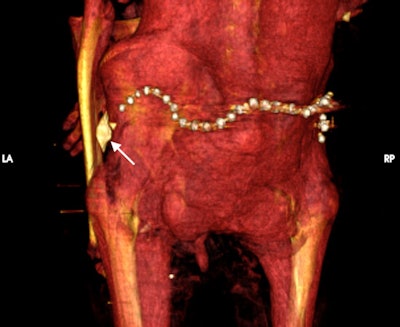 3D CT image of the surface of the lower back of mummy Amenhotep I shows a beaded metallic girdle (likely gold) at the back of the pelvic region and a faience amulet in the shape of a snail shell (arrow) in the left hip region. All images courtesy of Dr. Sahar Saleem et al and Cairo University.
3D CT image of the surface of the lower back of mummy Amenhotep I shows a beaded metallic girdle (likely gold) at the back of the pelvic region and a faience amulet in the shape of a snail shell (arrow) in the left hip region. All images courtesy of Dr. Sahar Saleem et al and Cairo University.The mummy of Amenhotep I was the only royal mummy to be left intact by modern Egyptologists who wished to preserve its fine outer mask and floral garlands. While it was x-rayed in 1934 and again in 1967, these studies could not establish an accurate age at time of death or cause of death, or provide details about how the pharaoh's face would have looked.
Saleem's team used a portable CT to show Amenhotep I's facial features and physical resemblance to his father, Ahmose I; his age, by looking at the surface of the symphysis pubis; and his stature.
According to the paper published in Frontiers in Medicine on 28 December, the pharaoh measured 168.5 cm in height, which was in line with other kings of the same period. He had an oval face, narrow chin and nose, sunken eyes, and slightly protruding teeth. He was 35 years of age when he died, according to CT, while previous x-rays had put him at 25 and 45 years old, respectively. CT also showed that his skeleton and teeth were healthy and provided no pathological cause of death.
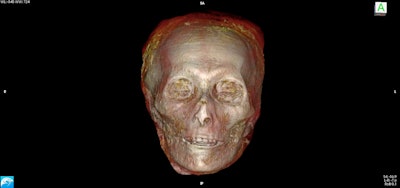 The 3D CT image showed an oval face with a narrow chin.
The 3D CT image showed an oval face with a narrow chin."These images reveal amazing details previously unseen without damaging the body or outer layers of the mummy. This study sets a model for digital unwrapping of mummies in ancient Egypt and other ancient civilizations," Saleem noted.
The protocol used may have applications in forensic medicine for studying cadavers that have been preserved by natural mummification due to extreme environmental conditions such as dry, hot deserts or freezing mountains, added Saleem, whose co-author was Zahi Hawass, PhD, the well-known archaeologist, Egyptologist, and former minister of state for antiquities affairs.
In terms of mummification technique, CT showed that the pharaoh's brain and heart were in place but that his viscera were removed. Brain removal was seen in late 18th Dynasty royal mummies such as that of Tutankhamun. Embalmers also removed the internal organs through an abdominal incision. The CT scan of the mummy of Amenhotep I revealed a vertical left flank incision similar to earlier mummies. However, later in the 18th Dynasty, most of the royal mummies have more oblique incisions, the authors noted.
Amenhotep I is also believed to be the first pharaoh to be mummified with his arms crossed over his chest, starting a new trend for New Kingdom royal mummies and later ones.
Reburial process
At some point, injuries were sustained by the mummy, most likely due to grave robbers, Saleem noted. However, 21st Dynasty priests reburied many royals and during this process fixed the injuries with pins, wood plaque, and metal, and placed amulets on these injured parts. In the CT images, it is clear that the 21st Dynasty embalmers mainly kept the original wrapping of the mummy. For example, the intact right arm and left leg remained individually wrapped from the original mummification and wrapping process. However, the 21st Dynasty embalmers rewrapped the injured left arm and right leg, placing the left arm alongside the body and wrapping it to the torso.
 Left image: Right lateral view of the mummy of Amenhotep I shows the body fully wrapped in linen, covered from head to foot with floral garlands and wearing a head mask. Right image: Picture of the head mask of the mummy of Amenhotep I made of painted wood and cartonnage.
Left image: Right lateral view of the mummy of Amenhotep I shows the body fully wrapped in linen, covered from head to foot with floral garlands and wearing a head mask. Right image: Picture of the head mask of the mummy of Amenhotep I made of painted wood and cartonnage.The 21st Dynasty repairs made to the mummy included the following:
- Fixing the detached head and fractured neck vertebrae with a resin-treated linen pad
- Covering the defective anterior abdominal wall with a linen band treated with resin
- Placing the detached left upper limb alongside the body
- Placing the two detached fingers of the left hand inside the abdomen
- Resting the disarticulated right foot on a wooden board with metallic nails
- Wrapping the body using pins (likely made of ivory or bones) to fix the bandages at the disarticulated left upper limb and right foot
Digital images depicted about 30 amulets and a girdle (formed of 34 golden beads) within the mummy. Some amulets were placed by the 18th Dynasty embalmers within the original wrappings, while a few were likely added by the 21st Dynasty embalmers. For example, the researchers believe that during the reburial of the mummy, the 21st Dynasty embalmers placed two amulets beneath the linen band used to cover the anterior abdominal wall defect and placed or maintained in place a golden beaded girdle at the back of the pelvis.
These embalmers covered the mummy with garlands of red, yellow, and blue flowers recognized as Delphinium orientale, Sesbania aegyptiaca, Acacia nilotica, and Carthamus tinctorius.
The CT images also revealed a mummified wasp that probably got trapped in the coffin accidentally at the time of burial, attracted by the floral garlands, as well as the sophisticated manufacturing technique of the head mask with inlaid stones, including obsidian to represent the eyes' pupils.
Mummy project
"As all the royal mummies of the New Kingdom were unwrapped in modern times, until now we have not had the opportunity to preserve and study the 21st Dynasty embalmers' reburial methods," added Saleem, who is a member of the Egyptian Mummy Project as well as a member of the scientific committee of exhibitions for the National Museum of Egyptian Civilization (NMEC) in Cairo.
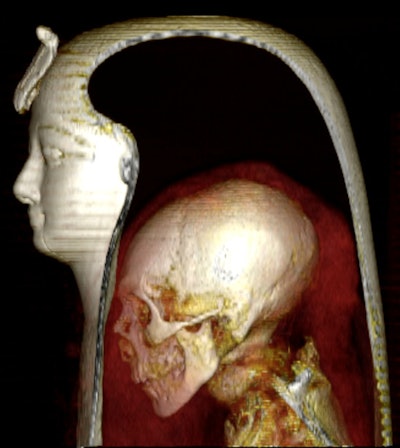 3D CT image of the head of the wrapped mummy of Amenhotep I in a left lateral view allows visualization of the component layers: the mask, the head of the mummy, and the surrounding bandages.
3D CT image of the head of the wrapped mummy of Amenhotep I in a left lateral view allows visualization of the component layers: the mask, the head of the mummy, and the surrounding bandages.The CT scanning process, which took place in May 2019 in a truck parked on the grounds of the Egyptian Museum at Tahrir in Cairo, took less than an hour. Following this, the reconstruction of the CT data, analysis of the imaging findings, and correlation with historical knowledge and literature took several months, explained Saleem, who has scanned more than 40 mummies of the New Kingdom.
This CT scan of Amenhotep I is part of the Egyptian Ministry of Antiquities' Egyptian Mummy Project, an ongoing scheme initiated in 2005 with the scanning of King Tut whereby the CT scanner was driven by truck to the Valley of the Kings in Luxor. In May 2019, Hawass and Saleem studied 13 royal mummies that had not been scanned before and were due to be transferred to the NMEC, including the mummy of Amenhotep I.
"The CT findings of this mummy, which had been kept at Tahrir museum for 120 years, and other royal mummies have helped to ensure that the preservation condition of each was suitable for their transfer to their new home at the NMEC in Cairo," Saleem told AuntMinnieEurope.com.
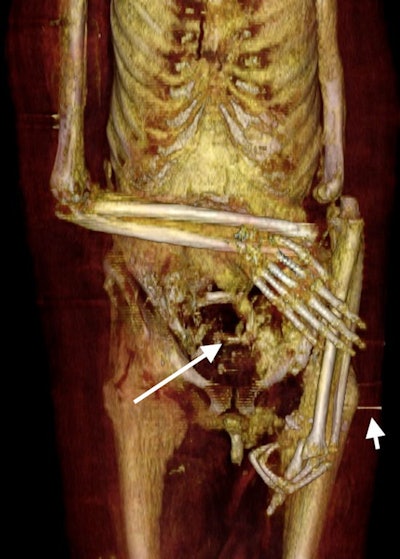 3D frontal CT of the lower torso and upper limbs of the mummy of Amenhotep I. The right forearm is flexed at the elbow and crosses the lower abdomen transversely; the right hand is dislocated at the wrist and is displaced anterior to the forearm. The dislocated left arm and forearm are placed extended along the left side of the body. The broken left (hand) has three flexed fingers; the missing two fingers are seen inside an anterior abdominal wall defect (long arrow). The fractures were probably inflicted by tomb robbers. The initial position of the arms was probably crossed in front of the body. A short pin is placed transversely across the bandages (short arrow) likely to fix the left disarticulated arm in place.
3D frontal CT of the lower torso and upper limbs of the mummy of Amenhotep I. The right forearm is flexed at the elbow and crosses the lower abdomen transversely; the right hand is dislocated at the wrist and is displaced anterior to the forearm. The dislocated left arm and forearm are placed extended along the left side of the body. The broken left (hand) has three flexed fingers; the missing two fingers are seen inside an anterior abdominal wall defect (long arrow). The fractures were probably inflicted by tomb robbers. The initial position of the arms was probably crossed in front of the body. A short pin is placed transversely across the bandages (short arrow) likely to fix the left disarticulated arm in place.The mummy of Amenhotep I has been kept at the NMEC since April 2021.
Amenhotep I, the son of Ahmose I, was the second king of the 18th Dynasty. He ruled for 21 years (1525-1504 B.C.), probably ascending to the throne when he was about 14 and co-reigning with his mother, Ahmose-Nefertari, at a time when Egypt was prosperous and safe.
The mummy of Amenhotep I was found in 1881 hidden at Deir el Bahari Royal Cache in Luxor; its original burial place is unknown because of a reburial project undertaken by 21st Dynasty high priests. Modern Egyptologists have theorized, perhaps cynically, that this might have been a means to loot burial treasure and other funerary equipment to reuse for new royal mummies at a time of political and economic instability when raw materials were scarce.
However, the new findings from this CT study would seem to refute this idea, according to Saleem, who said the remains have clearly been carefully repaired and had amulets added.






